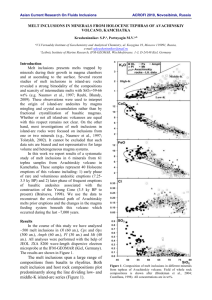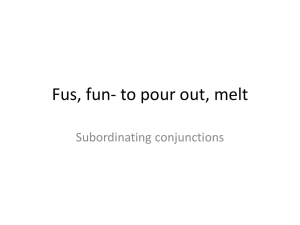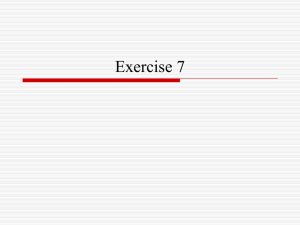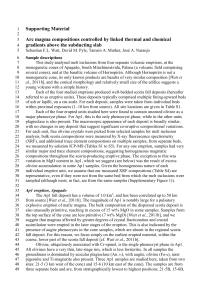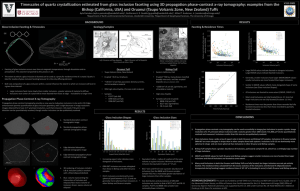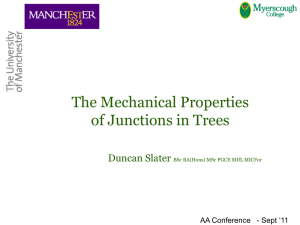Melt inclusions in basaltic and associated volcanic rocks
advertisement
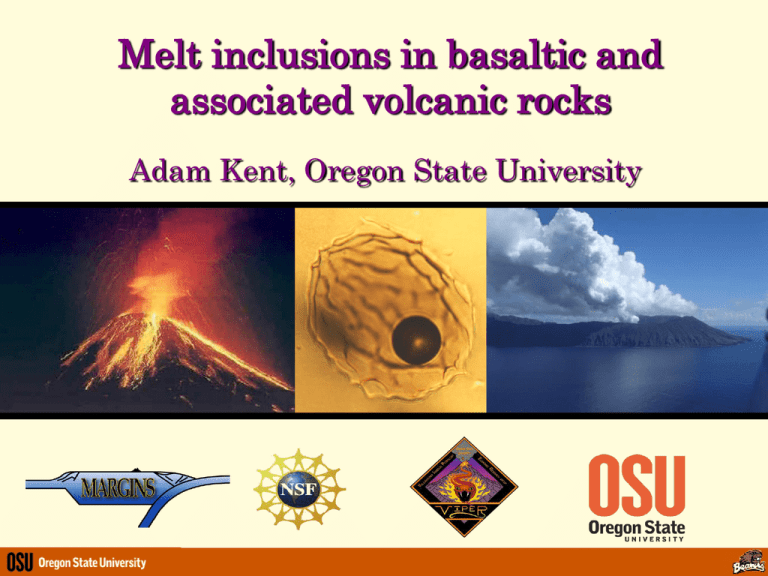
Melt inclusions in basaltic and associated volcanic rocks Adam Kent, Oregon State University Melt inclusions: An introduction “Parcels” of melt trapped in igneous crystals Fluid inclusions Occur in basaltic and related rocks wherever they are found: Arcs, OIB, CFB, MORB, LMI, ET’s Silicic and Plutonic Rocks 50 µm Xenoliths Saal et al. 1998 Scope: Basaltic and related volcanic rocks Scope: Basaltic and related volcanic rocks Nanos gigantum humeris insidentes Bernard of Charles, 1159 Why study melt inclusions? Melt inclusions preserve compositions that are different from those of erupted lavas/tephra 9°N Mid Atlantic Ridge Ultra-depleted Sobolev and Shimizu, 1993 Why study melt inclusions? Melt inclusions preserve compositions that are different from those of erupted lavas/tephra 1. More variable than host and associated lavas • • • Bulk rock, Matrix glass “Averages” Provide larger data sets per rock Preserve low volume or low survivability melts • Primitive Melts 2. Trap volatile elements • Compare volatile and non volatile behaviour 3. Provide melt samples in altered rocks But there’s a catch Melt inclusions are NOT a universal panacea! • Specific samples: phyric ± rapidly cooled • More work/time/money per sample – Mineral separation, mounting and polishing • Specialized analysis techniques – Melt inclusions are small! – Typically (trace element and isotope) analyses are less precise – Isotopic data are limited • Require significant additional interpretation Melt Inclusion Variations Magmatic • Crystallization • Assimilation • Magma mixing • Source heterogeneity • Degassing Inclusion-specific • Boundary layers • Post-entrapment crystallization • Re-equilibration with host or external melt • Non representative trapping i.e. things that drive changes in magma compositions i.e. things that are unique to inclusions Inclusion-Specific Processes • Re-equilibration between inclusion and host – Portnyagin et al. 2007, Spandler et al. 2007, Cottrell et al. 2002, Danyushevsky et al. 2000; Gaetani and Watson, 2000, 2002 • Preferential trapping of unusual, nonrepresentative compositions – Michael et al. 2002, Danyushevsky et al. 2004, Yaxley et al. 2005 • Trapping boundary layers – Kohut and Nielsen, 2004; Faure and Schiano, 2005, Baker et al. 2008. Goldstein and Luth, 2007 • Alteration of inclusions – Nielsen et al. 1998 Analysis Major Elements EMPA Yes SIMS LA-ICP-MS Trace Elements Isotopes S*, Cl Yes Maybe Volatiles C,H,F,S,Cl Yes FTIR Pb, Sr H*,C *plus speciation H, Li, B, Cl, S, O, Pb How do melt inclusions form? The widespread occurrence of melt inclusions in basaltic rocks shows that their formation is a normal part of the process of crystallization in igneous rocks Melt inclusions form in regions of relatively slow crystal growth How do melt inclusions form? Modified from V.S. Sobolev and Kostyuk 1975; Roedder, 1979, 1984 Faure and Schiano 2005 Do melt inclusion formation processes fractionate trapped compositions? Baker et al. 2008 Not all experimental studies show boundary layer effects •Most natural suites do not show clear indications of boundary layer effects •Perhaps we sample larger inclusions (only significant at < 30 µm) •Longer isothermal times in natural samples •Are boundary layers static? •Kinetic experiments Evolution of melt inclusions after trapping Important impact on physical appearance and chemical compositions 25 µm 50 µm 25 µm Evolution of melt inclusions after trapping Wallace, 2005 1. Venting/breaching/alteration 2. Post-entrapment crystallization 3. Diffusive exchange Correction for postentrapment crystallization Experimental • Reheat to (estimated) trapping temperature Numerical • Based on chemical equilibrium –Olivine: KDFeO*/MgO = 0.33 ± 0.03 QuickTime™ and a TIFF (LZW) decompressor are needed to see this picture. Loihi Seamount (Kent et al., 1999) Compatible elements are the least robust after correction for post-entrapment crystallization Equilibration between Host and Inclusion Equilibration more rapid at • Higher Diffusivity • Higher Temperatures • More compatible • Larger inclusion • Smaller host Qin et al. (1992) Fe Loss Yaxley et al. 2005 • Negative correlation between measured FeO* and Fohost • Anomalously low FeO* wrt liquid line of descent Danyushevsky et al. 2000 Trace element re-equilibration • The most robust data sources in melt inclusions are slow diffusing and incompatible elements – Altered only by dilution/concentration – Ratios unchanged Are incompatible trace elements affected by diffusional re-equilibration? Cottrell et al. 2002 REE equilibration with host after 2500 years Cottrell et al 2002 Slater et al., 2001 Trace element re-equilibration Spandler et al. 2007 Baffin Island olivine-hosted n = 103 50 Standard Deviation (%) 45 40 35 30 25 20 15 10 Diffusion in basalt melt 5 Diffusion in Olivine 0 -12 -10 -8 -6 Log Do (cm2/sec) -4 Preserve inter-crystal variations Driving Force? The message from melt inclusions: Variability • In many basaltic systems it is clear that the primary control on melt inclusion compositions is the variability of melts present within the system – These are sampled by erupted lavas as well, but are homogenized – Implies large scale mixing of smaller melt “batches” is extremely widespread • Melt inclusions and host lavas related by mixing • Basaltic melt generation and transport systems are variable at scales smaller than individual eruptive units (factors of 10’s) • Phenocrysts • Melt inclusions sample this variation • Some real and apparent homogenization (mixing) occurs prior to eruption • Rates: Transport >> Reequilibration Comparison between melt inclusions and host lavas Baffin Island olivine-hosted Melt inclusions sample the same population of melts as host lavas Variability in trace element composition is driven by the same processes in inclusions and in lavas Magma Magma Melt Inclusion Kellogg et al. 2002 Baffin Island olivine-hosted sinclusions slava n n 90 [T heistareykir: n 30100 Slater et al. (2001) MacLennan et al. 2003] Borgahraun, Iceland Maclennan et al. 2003 Comparison between host and inclusions provides a means to assess relationship between inclusions and magmatic systems 9°N MAR Ultra-depleted Sobolev et al 2000 Sobolev & Shimizu 1993 • Anomalous melt inclusions – Low volume melts? – Magma chamber or primary? – Artifacts of trapping? “ There is no necessary connexion between the size of an object and the value of a fact, and…though the objects I have described are minute the conclusions to be derived from the facts are great ” Sorby 1858 Geol. Soc. London. Quart. Jour. 14 453-500 [from Roedder (1979) Bull. Mineral.]


